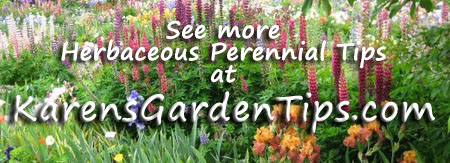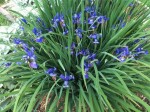 It seems that most plants I want to buy like well drained soil but sometimes I really need one for a wet spot in the garden where many plants have tried to grow but failed because of excess moisture. It is nice to know that there are some fine plants of all sizes and colors that actually like wet soil and will thank you for putting them in a moist spot by growing quickly and producing an abundance of flowers. Some of these plants will even do well in boggy soils.
It seems that most plants I want to buy like well drained soil but sometimes I really need one for a wet spot in the garden where many plants have tried to grow but failed because of excess moisture. It is nice to know that there are some fine plants of all sizes and colors that actually like wet soil and will thank you for putting them in a moist spot by growing quickly and producing an abundance of flowers. Some of these plants will even do well in boggy soils.
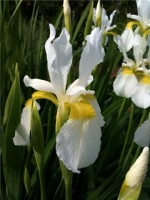
 Siberian iris (Iris sibirica)
Siberian iris (Iris sibirica)
These beautiful iris are easy to grow and will do well in both a boggy soil or a “moist, well drained” one so you can change your mind at any time and transplant it. They will be smaller when grown in less water but attractive all the same. Each plant produces several stems bearing 2-5 elegant flowers that are more delicate than the flowers of German bearded iris. The plants are less susceptible to soft rot and iris borer than German bearded iris making them a practical choice for the average gardener. There are hundreds of cultivars varying in color, size, and vigor; ‘Caesar’s Brother (violet-blue) and ‘White Swirl’ are two outstanding ones that are readily available.
-
Size: 24-36’ H x 24’ W
Bloom: One to 2 ½” lowers are borne in various shades of lavender, blue, and white touched with yellow in May.
Light: Full sun
Soil: Moist to wet; average fertility.
Hardiness: Zones 3-9
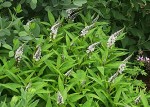
 Gooseneck loosestrife (Lysamachia clethroides)
Gooseneck loosestrife (Lysamachia clethroides)
One of my all time favorites, I adore this thug even though it can be invasive when give a moist soil. It will show up in very unexpected places but is very easy to pull out. The endearing shape of the flower heads is welcome in the garden as well in an arrangement inside. The foliage is attractive all season even in summer heat and humidity. This is NOT a plant for a bog but it loves moist soil.
-
Size: 3’ H x 3’ W.
Bloom: Small white flowers are borne on gooseneck-shaped stem tips in mid summer.
Light: Full sun to partial shade.
Soil: Avererage moist soil.
Hardiness: Zones 3-9
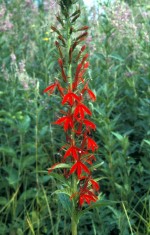
 Cardinal flower (Lobelia cardinalis)
Cardinal flower (Lobelia cardinalis)
The sight of the brilliant red flowers of cardinal flower along a stream or pond is a treat for the eyes. This lobelia is native to most of eastern and central US but has been bred to produce hybrids with salmon, pink, and white forms. The flowers of the species are borne on leafy stems that rise above a dark green basal rosette but some cultivars have rosettes of bronze or reddish green. The plants produce an abundance of seed and will naturalize if they like their site.
-
Size: 2-4’ H x 2’ W.
Bloom: Red flowers with protruding stamens are borne in clusters on tall stems in summer.
Light: Full sun to partial shade (afternoon sun needed in most areas)
Soil: Rich, moist soil.
Hardiness: Zones 2-9.
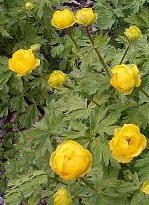
 Globeflower (Trollius x cultorum)
Globeflower (Trollius x cultorum)
The large deeply cut lobed leaves of globeflower are as attractive as the buttercup-like flowers that are borne singly on erect stems. The flowers are made up of yellow to orange incurved sepals that surround small petals and a mass of stamens that are visible when the flowers open. Many good cultivars are available varying in height and color from light yellow to deep orange and some are excellent cut flowers. The bad news? Globeflowers do not like heat and are suitable only for cool, moist soils. Forget this one if you live south of zone 6.
-
Size: 2-3’ H x 3’ W.
Bloom: Yellow to orange flowers appear in late spring.
Light: Sun to partial shade.
Soil: Cool moist soil.
Hardiness: Zones 3-6.
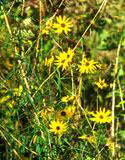
 Swamp sunflower (Helianthus angustifolia)
Swamp sunflower (Helianthus angustifolia)
When I hear the name sunflower I envision tall flowers that grow along the highways thriving in the dry soil. Not this one. As its common name tell us, it like things wet, swampy wet, in fact. It is tall and a bit on the wild side but it is a good plant for the back of a wet area with other smaller plants in front of it to tame it down. Its flowers are less coarse than other sunflowers and they appear in the fall when most other plants are gone. If you need a tall fall blooming plant for a low area that collects water such as a swale or ditch, this is a good one to try.
-
Size: 6-8’ H x 4’ W.
Bloom: Masses of 2-3” bright yellow flowers appear in fall.
Light: Thrives in full sun; tolerate some shade but may be floppy.
Soil: Rich, fertile, moist soil.
Hardiness: Zones 6-9.
Planting a wet area can be challenging but these 5 moisture loving plant show that there are plants that can meet the challenge and provide variety in color, texture and height through out the growing season. Think of a wet area as an opportunity rather than a problem.
